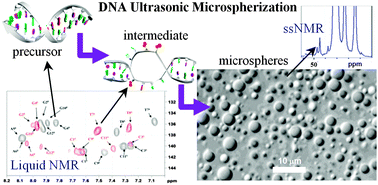NMR studies of DNA microcapsules prepared using sonochemical methods†
Abstract
DNA molecules were recently converted using ultrasonic irradiation into microcapsules that can trap hydrophobic molecules in aqueous solution. These DNA microcapsules are capable of penetrating prokaryotic and eukaryotic cells, delivering drugs and transferring genetic information e.g. for protein expression into the host cells. DNA molecules of different sizes and structures can be assembled into spherical capsules, but to date, the interactions that hold them together in these large structural constructs are unknown. In the current study, capsules prepared from a 12 base double helix DNA were investigated using NMR spectroscopy. Solution NMR studies of the DNA emulsion reveal DNA molecules with a perturbed structure with a size similar to the precursor DNA based on diffusion NMR measurements. 2D NMR correlation measurements and chemical shift perturbation analysis show partial unzipping of AT base pairs in the centre of the modified duplex, freeing nucleoside bases to interact with other bases on other precursor molecules thereby facilitating aggregation. Slow tumbling of the microspheres renders them invisible in solution NMR spectra; therefore magic angle spinning NMR measurements are performed which provide limited evidence of the DNA in the microcapsule state.


 Please wait while we load your content...
Please wait while we load your content...